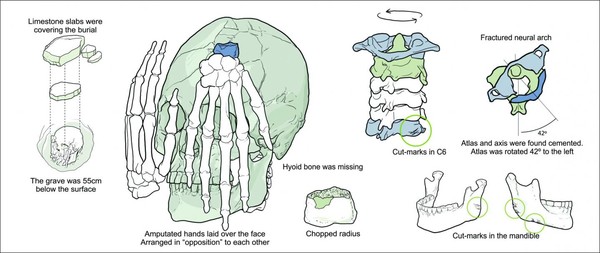The oldest known ritual decapitation of a human being occurred 9,000 years ago in the Lapa do Santo area of Brazil. André Strauss from the Max Planck Institute for Evolutionary Anthropology in Germany and colleagues discovered the partial remains in a relatively shallow grave in a rock shelter that is known to have been occupied by man for at least 12,000 years.
The skull, jaw, first six cervical vertebrae, and both hands were buried 22 inches below the surface of the earth and covered by two limestone slabs that appear to have been fitted to the grave. The hands were places in opposite directions, one pointing upward and the other pointing downward, in front of the skull. The jaw had a series of v-shaped cuts on the back of the jaw and on the center of the jaw. The top two cervical vertebrae, the atlas and axis, had been forced together with the atlas at a 42 degree angle from its normal position.
The researchers designated the partial remains as Burial 26. The placement of the skull and hands indicate that this was a ritual decapitation that occurred after death and was not the result of trophy taking from an enemy. The hunter-gatherers that inhabited the area 9,000 years ago may have used this technique to honor a particularly important person in their culture like a chieftain or a priest. There have been no similar finds at the site to date. The lack of more than one ritual decapitation makes any supposition as to the reason for the act difficult. The remainder of the body may yet be discovered.















